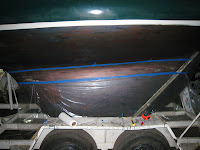
All it took for us to end up with our very own Shields was Niki coming home from work, and saying, in a very offhand way, "maybe we should just buy a boat".
I don't know if she was entirely serious at the time, but about 2 weeks later we were there at the yard, tearing the boat apart. Money had been sent out, parts were on order and we were definitely in "lots of stuff is happening quickly" mode.
Looking back, and judging by how fast we pulled it all together, it seems like I've been planning on doing this for a while, probably since about the second time I sailed a Shields. Seems that having someone else think that it wasn't a terrible idea was all it took to make it happen. And Niki is a bit boatcrazy too, and is in fact driving a lot of the cool upgrades we're making. I don't have to say it, but Niki is amazing. She's also going to be doing bow. (!)
So, the why is easy: they're absolutely great boat to sail whether you're daysailing or racing. This particular one had been sitting in the yard for a while, and our local racing fleet would be much better off with one more boat out racing. Since I own a boat rigging business, I could devote a lot of time to it in the slow winter season. I've sailed on Shields for the last 7 years, and have done pretty well as crew. The few times I've gotten to drive a boat it's been great fun. Niki has sailed Shields on and off for the last 3. We have somehow managed to sail together pretty well as a couple too.
The how is going to be, quite simply, a lot of work. We could probably do so a couple hours of work and throw the thing in the water next spring, but while we're doing it, we might as well do it right! We've got some big plans for the boat, to make it faster, easier to sail, and while we're at it, prettier.
The boats got some damage, where the last owner had a bad interaction with a powerboat on the 4th of July. Not that hard to picture if you've seen Lake Michigan on the 4th. Picture if you will a parking lot filled with cars, then picture everyone getting ridiculously drunk and driving around at max possible speed. It's great! What this means for us is that the bow of the boat is pretty messed up. The deck is peeled back for about 8", and the stem is cracked and shoved to the side for the top 6" or so. This is going to take a lot of grinding, glass work and fairing to make right.
While we're at it (may as well be the boat motto judging by how it's affecting our planning) we wanted to paint the topsides. Its currently dark green, and doesn't look too bad. I've always wanted a gray boat, and as long as we're painting the bow..... we might as well strip, fair and paint the topsides! We're probably using Interlux Perfection in the platinum color, which is a fancy way to say medium gray.
The bottoms in good shape, but in order to have no excuses, I wanted to fair it. So we might as well strip it, reglass the keel joint, fair it and paint it. Fast bottom's are cool.
The deck is nice and solid, but we're going to do a LOT of tweaking to the deck layout. The watchwords here are : simpler, easier, and lighter. So again, while we're filling in holes and things, we might as well paint the damn deck too. Just white, and no fairing. I can't make myself longboard something that has no effect on performance!
Of course we've got lots of plans for rerigging the boat, and I'll get in to that in later installments.
For now we just came back from a fun day of boatwork. I do this kind of stuff for a living, because I love it. Even when it's miserable difficult work, and hard business, I love it. So even I was surprised how satisfying it was to work on my boat, how much better it can be. Even though today was some pretty gross work, I loved every minute. Niki was there too, and it's always better working when theres someone fun around.
What we did:
Took an insane amount of stuff off the boat. This ranges from things like the padeyes for attaching the cover to (BAD WEIGHT) to lots of little storage dohickeys ( there are coatracks on the front bulkhead!!) to just extra crap on the boat (you do not need 4 vicegrips and 8 rolls of tape). I'm tracking the weight, with a goal of taking 200lbs off the sailing weight of the boat. That seemed like a lofty goal, but Im starting to think it's doable. I will photo some of the hilarious crap that we pulled off, such as two different ensign staffs. I don't think we'll need these , unless we get a burning desier to have more flags on the boat (no).
Started working on the bottom. This meant taking the old bronze keel faring strips off prepping for the new glass ones. I also drilled a few holes in the deadwood, which resulted in about a gallon of water seeping out. This boat has sat for two years with that much water in the wood! Hope that doesn't hurt us later.
Can't wait to get back there!
Total hours:
Kristian 4
Niki 4
satisfaction: through the freakin roof













